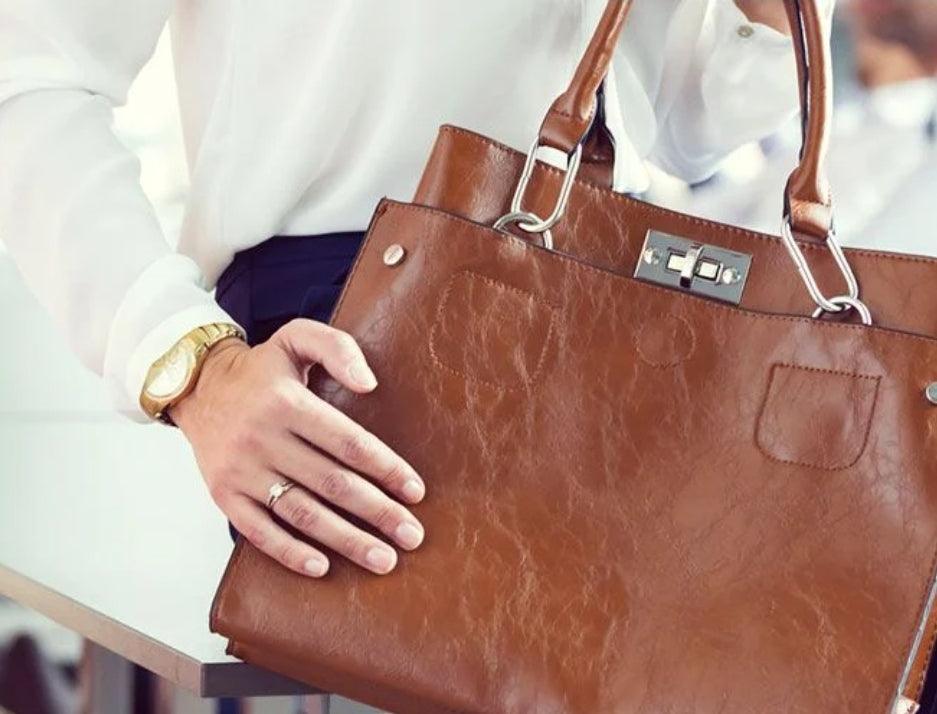
Leather care
A leather bag is an accessory that has a certain cost and that you want to keep for as long as possible.
It is therefore very important to provide it with certain care in order to optimize its lifespan.
Leather is a living material that cannot withstand all types of treatment.
It is therefore necessary to learn how to treat it well so that it accompanies you for years.
But before maintaining the leather, it is sometimes necessary to clean it because the treatment
applied would penetrate the dirt deeply
present on the surface, which would be irreversible.
CLASSIC MAINTENANCE
Whether your leather is stained or dusty, various stain removal techniques or products are often offered.
Certain common points serve as a basis for leather care and it is necessary to take note of them before getting started.
Cleaning
When cleaning leather, and unless otherwise indicated,
use cotton, in a ball or in the form of a makeup remover disc, you will proceed with circular gestures, without ever insisting too much and limiting friction as much as possible.
Another important point is to always
test the stain remover in an inconspicuous area before treating the entire surface.
If a problem ever arises, you could change products without any real disaster.
If the color of the leather is found on the cotton, there is a problem and the current treatment should be stopped.
Cleaners
The following products and their method of application are the most common:
The water
Although it doesn't seem very logical, water is a solution in the case where light dusting is sufficient.
For smooth leathers (which do not have the appearance of
velvet), wipe with a slightly damp cloth and
possibly dry with another.
Make-up remover milk
Make-up remover milk or baby cleansing milk are very effective.
It is advisable to pour small amounts of milk onto the cotton and apply it in circular motions over the entire surface of the leather.
Cotton should be changed as soon as it becomes dirty.
After letting it dry, wipe the leather with a soft cloth.
Glycerin
It will be used in the case of fragile or slightly worn leather.
The technique to be used will be identical to the use
a make-up remover milk.
Glycerin can be purchased at a pharmacy for a relatively inexpensive price.
Glycerin soap
It can replace pure glycerin.
A dampened sponge will be rubbed with the
soap.
Cleaning is done in circular movements
and the sponge will be rinsed regularly.
As soon as an area is cleaned, wipe it with a cloth to remove dirt and do not rinse.
Glycerin nourishes and softens the leather.
Then, apply a moisturizing milk and let dry
about eight hours, before buffing with a soft cloth.
This way, your leather will regain all its suppleness and shine.
The clay stone
It allows you to clean very dirty leather.
Clay stone can be found in organic stores and in the vast majority of DIY or supermarket stores.
To apply it, lather the stone with the dampened sponge provided.
Pass the sponge over the leather and rinse with another sponge to remove all traces of clay.
Then dry the treated surface using a
soft cloth.
CARE OF NUBUCK, SUEDE AND SUEDE LEATHER
Nubuck and suede require very specific leather maintenance which requires purchasing a specialized kit.
A soft brush will remove all dust and dirt.
A suede cleaner spray, followed by brushing
Immediate will remove stubborn stains.
A suede eraser and brushing should remove the deepest stains.
A waterproofing spray will prevent,
the future the vast majority of stains and
facilitate the maintenance of nubuck leather.
WHAT YOU SHOULD NEVER DO WHEN
LEATHER CARE
Now that we have detailed some of the
best practices regarding leather care, it is just as important to mention what absolutely should not be done.
While some errors may seem logical,
others are much more difficult to discern because they are anchored in our habits.
Never put a leather item in the washing machine or iron it.
He would definitely be ruined.
It should also not be exposed on too much
Ion period neither to the sun, nor to the moon, nor to a heat source.
This exposure would cause the leather to dry out, the color to lighten, and even cracks.
Leather should never be treated with any material
abrasive (sponge, stiff brush, sandpaper).
This would have the effect of modifying its texture or permanently removing its color.
Applying acetone or other solvent
would irreparably strip the leather.
Shoe polish, if not bad in itself, cannot
apply only to shoes.
Shoe polish is a paste that remains on the surface and blocks the pores of the leather.
Although some good quality shoe polishes have some nutritional properties, they prevent the leather from breathing and it will eventually crack.
With all these tips, you are familiar with leather care!
